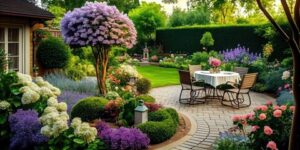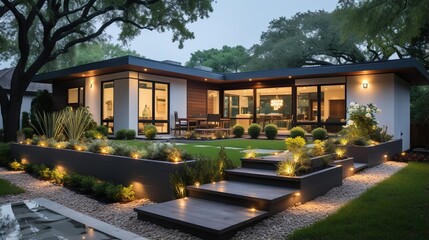Landscaping Stafford VA is an art and science of creating attractive and functional outdoor environments. It uses principles such as balance, proportion, unity and emphasis to produce a visually harmonious landscape.
Before hiring a professional landscaping team ask yourself what you want from your outdoor space. For example do you have a lifestyle that requires an outdoor kitchen, pool or fire pit?
A well-done landscape enhances the beauty and economic value of your home. It can also provide environmental benefits, such as buffering noise and cooling temperatures, as well as reduce energy bills through thoughtful placement of trees and shrubs. It can even improve soil health and drainage, as well as protect your property from flooding and wind damage.
A landscape designer is a professional who helps you bring your vision for outdoor spaces to life. He or she has design education, advanced horticultural knowledge and graphic and drafting skills. During the planning stage, a landscape designer analyzes your needs, surveys the site and creates functional diagrams. He or she may use online software to help you visualize your landscape design before starting any work.
Unity, simplicity, variety, balance, line and sequence are the design principles that help landscapes look unified and attractive. Theme is also a factor that affects the overall look and feel of a landscape. The theme may be based on your personal style, such as a Japanese garden with pachysandra ground cover and rhododendron or dogwood shrubs. Or it may be based on the landscape’s location, such as a woodland setting with shade-loving plants and redbuds.
Color is another important consideration. It can be warm, cool or neutral. Choosing a limited color palette will help your landscape design look more intentional and professionally designed. Using a color wheel can help you choose colors that coordinate well together.
Texture is another design element that influences how a landscape looks. A bed of bedding plants that all have a similar texture may look monotonous and flat, whereas a mix of different textures adds interest and contrast to your landscape.
Form refers to the shape of plant and hardscape elements. For example, a shrub’s formal upright form contrasting with the more organic shape of a tree creates visual balance in your landscape. The form of a water feature can be varied as well, from the symmetrical vertical lines of a fountain to the asymmetrical curved flow of a waterfall.
Plantings
A landscape design is not complete without the use of different types of plantings. These include trees, shrubs, flowers, and grasses that add color and texture to the space. They also provide shade, help cool the air, and reduce noise pollution. Ideally, plantings should be grouped according to their size and maturity. This will ensure that they are not too large to fit in the space and also prevent them from blocking windows or doors in future.
A well-designed landscape enhances curb appeal and improves the value of a property. It can also improve mental health by reducing stress and improving moods. Moreover, it helps individuals bond with their family and friends by providing an environment where they can relax. Additionally, it can protect the soil and surface from environmental hazards like flooding and erosion.
Landscaping can also increase a home’s energy efficiency. Proper landscaping can decrease heating and cooling costs by blocking the sun’s rays from a building, reducing air flow and increasing aeration, and funneling cool summer breezes into homes. It can also block glaring sunlight and act as a natural privacy screen. In addition, proper landscaping can help in the conservation of water by reducing the need for irrigation and using drought-tolerant plants.
Plant landscaping can create a sense of place by interpreting the cultural characteristics and history of a site. A landscape can highlight a building’s architecture or create a sense of movement with a flowing stream or meandering river. Plants can also reflect the mood of a space by generating particular associations or triggering certain emotions.
A well-designed landscape can also add comfort to an individual’s life by providing a comfortable seating area to relax or read. It can also serve as a place for entertaining guests and barbecues. It can also serve as a safe area for children to play outside. Keeping the lawn and other plants trimmed will prevent pests from invading a home. This can be a difficult task but it is essential for good landscaping. Furthermore, pruning and weeding can be considered healthy exercises as they burn calories.
Hardscaping
The hardscaping part of landscape design involves non-living elements such as stone walkways, brick patios, and wood fences. Hardscaping adds structure and defines space in the garden and can dramatically alter its appearance and feel. Hardscaping can also be used to solve practical problems such as preventing erosion and creating drainage solutions.
Unlike the plants, flowers, and shrubs in your landscape, hardscape features are permanent structures that can be constructed to last for many years. This makes them a more significant financial investment than softscape components like grass and trees. However, they can enhance the value of your property by improving its aesthetic and functional appeal.
There are many different types of materials that can be used for hardscaping, from natural stone to pavers, concrete to brick, and even wooden decks. Each has its own unique look and feel that can complement your landscape and home. When choosing the materials for your hardscape project, it’s important to consider their durability, maintenance costs, and color options. It’s also a good idea to select a material that will blend well with the existing architecture of your home and neighborhood.
When designing your hardscape, it’s important to include a focal point that will draw the viewer’s attention. However, it’s equally important to include places for the eye to rest along the way. This will keep the landscape from feeling too sterile and unnatural. Incorporating curves and rounded edges into your hardscape design will help achieve this.
Hardscaping is also a great opportunity to make your yard more functional by adding areas that can be used for relaxing, entertaining, or dining. Adding a fire pit or outdoor kitchen to your garden can transform it into a versatile space that can be enjoyed year-round. Retaining walls and stone stairs can also provide easy access to any area of your garden by flattening sloping or uneven terrain.
Once your hardscape project is complete, it’s important to maintain it regularly. This will protect the investment you’ve made in your landscaping and extend its lifespan. Maintenance tasks can include re-sealing surfaces, repairing cracks, and weed control.
Maintenance
A well-maintained landscape is not only visually appealing, but also boosts the value of your home or commercial property. The maintenance process involves trimming and pruning bushes, plants, and trees to keep them healthy and attractive. It also includes installing water features like fountains and ponds to add movement and visual appeal.
Keeping up with routine landscaping maintenance will not only ensure that your landscape stays beautiful, but it will help you avoid costly repairs and replacements down the road. Regular inspections can help identify issues such as overgrowth of vegetation, pest infestations, or deterioration of outdoor hardscapes before they become more serious problems. In addition, regular landscaping maintenance can prevent safety concerns, such as overhanging branches or slippery walkways, from causing accidents or injuries.
When compared to properties with drab, overgrown landscapes, homes that have a beautifully maintained yard are shown to sell more quickly and at higher prices. Furthermore, many people report feeling happier and less stressed when surrounded by natural beauty, greenery, and fresh air. This is especially true for business establishments that can benefit from the positive impact of a stunning landscape by attracting more customers and boosting employee morale.
While many common forms of maintenance are harmful to the environment, sustainable landscape maintenance utilizes best practices that promote environmental health and protect human health. These include using organic mulches, reducing the use of chemical fertilizers, and implementing water conservation measures such as capturing rainwater, minimizing irrigation, and choosing drought-resistant plants.
Landscapes that are designed to attract and support pollinators, such as bees and butterflies, are another aspect of sustainable landscape maintenance. This approach is essential for maintaining the ecosystem and ensuring that Hawaii’s rich flora thrives.
Selecting the right vendor for your landscape maintenance is crucial, as they will be responsible for the overall look and feel of your property. You need to find a company that understands your vision and can provide consistent, high-quality services. Fortunately, VendorSmart makes it easy for you to compare quotes from the best landscape maintenance companies in your area.
